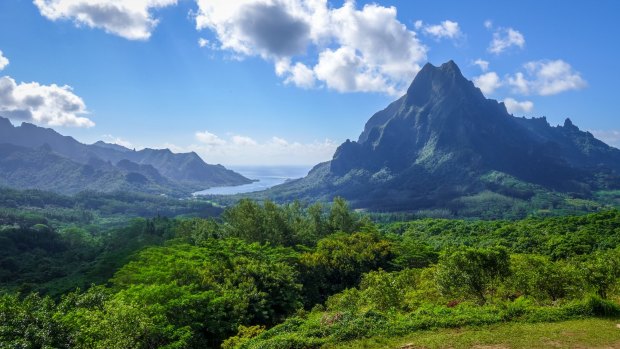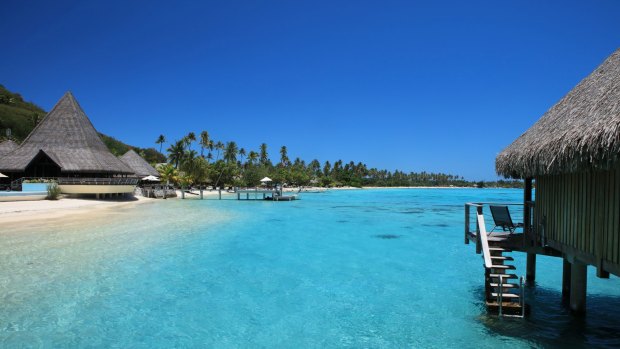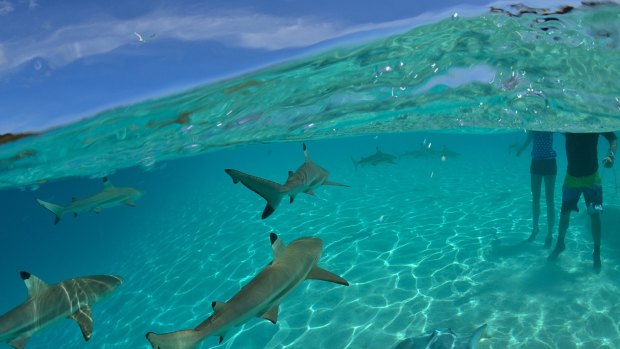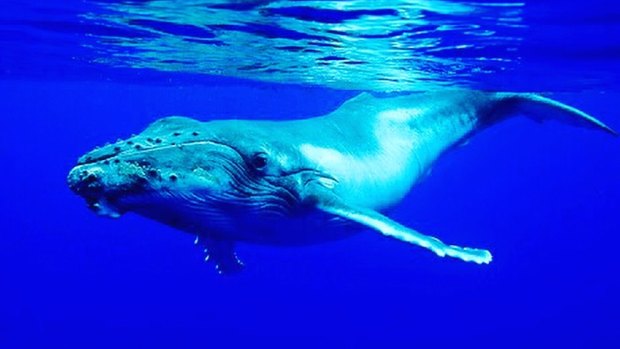This was published 6 years ago
Tahiti: Swimming with whales, sharks and stingrays in French Polynesia

Stunning Moorea Island, part of French Polynesia, lies northwest of Tahiti.Credit: Shutterstock
There's nothing but the deepest blue all around. No fish, no seaweed, no coral, just dark blue emptiness. But there are, apparently, humpback whales. Our guide, Torea, has seen a puff of water above this spot so we've jumped off the boat into the ocean in search of them.
There are 10 of us in the warm waters off the island of Moorea in French Polynesia, mostly young Italian honeymooners and an older French couple. Our boat, driven by its owner, Maui, is idling just beyond the reef that encircles the island, within sight of the main island of Tahiti.
We swim around in circles, flippers occasionally colliding, as we strain through goggles to see the ocean floor 100 metres or so below.

Sofitel Moorea Ia Ora Beach Resort Tahiti.
Just as I begin to doubt Torea's spotting skills, I see a faint white line far, far below me. Stare at it for long enough and the outline of a whale becomes visible, and even at this distance it looks big. Then I see a second, smaller tail – it's a mother and baby. The baby moves more, despite being tucked safely under the mother to prevent it floating as it's so much lighter.
Then suddenly they are both becoming bigger – and closer. Here in Moorea, humans are meant to stay about 10 metres away from whales in the water but there's little time to get out of the way when they are heading up for air. When they break the surface they are less than five metres from us, then they descend again, disappearing into the blue. I didn't feel scared that their enormous bodies were so close to mine – I was too busy marvelling that I was actually swimming alongside them, and momentarily accepted in their world.
After some excited thumbs up between the group, we spend another 90 minutes in the water with Torea. He spots another pair of humpbacks, then a little while later, another two, and on it goes. You have to be a fairly strong swimmer to keep up with Torea but he constantly checks we are okay – anyone who needs a rest can hold onto a boogie board or be collected by the boat.

Black-tip reef sharks pass close in the Moorea Lagoon.Credit: Shutterstock
When we reluctantly climb back onboard I excitedly ask Torea how many whales we saw – 10? 12? Oh no, he says kindly – the same two, they kept swimming and so did we.
When there's cotton on the trees, goes the saying in Tahiti, there are whales in the water. From August to September, when the floss-silk trees are covered with clumps of fluffy white cotton seeds, the humpbacks travel from Antarctica to the warmer waters of the Pacific to birth and raise their calves, before returning south.
The novelty of introducing tourists to whales hasn't worn off for Maui Ciucci. He worked for Tahiti Tourism for 15 years in the capital of Papeete before deciding to return to his island home and take an even more hands-on tourism role by buying his own boat. He's half Tahitian, half Italian, and switches constantly between French, Italian and English.

There are rules about swimming too close to whales, but Tahiti's humpbacks don't always comply.
Swimming with whales, he says, is "a privileged moment and each time it's different. One time there was a whale, sleeping and floating on the surface, only a metre away from me. I could have touched it".
Getting close to humpback whales is one of the highlights of exploring the lagoon around Moorea – closely followed by swimming with sharks and rays at Shark Bay. This is our next stop on Maui's Corallina Tours, and popular among other tour operators, too. We stop alongside five other boats, plus countless jet skis. The water is shallow, no more than chest high, and full of black tip reef sharks and rays.
The sharks circle us but don't make contact – although they look fearsome enough to make some Australian tourists too apprehensive to get into the water. The stingrays, meanwhile, are remarkably bold, brushing against us and hustling for the fresh fish that Torea is holding, gliding up his body towards his raised hand. It's quite something to be in the ocean with them, albeit an ocean as clear as a backyard swimming pool.
As a passionate Pacific traveller since childhood, I wondered how French Polynesia would compare to my other favourite islands. Moorea reminded me of many places, but also had its own distinctive feel.
The locals were as friendly as in Fiji, but all spoke French as in New Caledonia. The lagoon waters were as beautiful as the blissfully unspoilt Isle of Pines or Champagne Bay in Vanuatu's Espiritu Santo, but with the added thrill of being able to safely swim with whales, sharks and rays.
Papeete, the capital, had the same faded colonial charm as the New Caledonian capital Noumea, with ornate European-style lamp posts lining the main road and Tahitian Pearl shops everywhere.
The mountains at the heart of Moorea were reminiscent of Kauai in Hawaii – in fact, the shared Polynesian culture of Tahiti and Hawaii comes through in the music, song and traditional dance.
Tahiti also felt appealingly remote – as with the Cook Islands, it's in our Pacific backyard, but also over the international date line.
"We are lost in the middle of the biggest ocean" was how one tour guide poetically described Tahiti. You really do feel in the middle of nowhere, in a good way, and quite safe given the security threats to travellers in other parts of the world.
And then there's the food – there's nothing like French heritage to lift the calibre of food in a Pacific holiday spot. At the Sofitel Moorea, where I stayed, the freshly-baked pastries were as good as in Paris. The resort had invited a French cheese master for a four-day festival and the cheese smorgasbord of about 150 varieties was mouth-watering. The combination of French and Polynesian food influences meant you could go from traditional hearty French casseroles to Polynesian favourites such as poisson cru (fish cured in coconut milk).
Tahiti has a reputation for being expensive – much like New Caledonia, another island where most produce is flown in from France, New Zealand or Australia – but there are ways to holiday affordably. You can shop at supermarkets and French-style bakeries for some meals rather than eat in restaurants three times a day. Or buy tuna or mahi-mahi fresh off the fishing boats, sold from racks by the side of the road, alongside stalls selling mangoes and pineapples.
French Polynesia, however, has a petit image problem. Mention Tahiti and most people think of the aquamarine waters of the lagoons and the over-water bungalows that originated there in 1967. You might not see much fanfare for the bungalows' 50th anniversary, partly because Tahiti Tourism wants to move the conversation on. Yes, they have over-water bungalows and the famed island of Bora Bora – but also so much more.
This is why I'm on Moorea, rather than Bora – the latter gets enough fanfare, so my visit is entirely focused on this bigger, more diverse island.
Moorea is well-developed and reasonably affluent, with houses set in well-kept gardens along most of the 60-kilometre road encircling the island. There are international resorts such as Sofitel, Hilton and Intercontinental, as well as more affordable accommodation such as house rental or staying with local families.
And there's also a lot more to do beyond the lagoon-based activities. Most tourists combine boat trips with excursions that focus inland and on Tahiti's culture, such as Yvette Leon's Moorea VIP Tours.
From the moment Yvette collects us at the hotel at 7.30am, her stories start flowing and barely pause for six hours. Today's tour group – two Australians, two Americans, two Argentinians, all packed into her air-conditioned mini van – is captivated by her tales of Polynesian history, culture and legends. She points out silhouettes of faces – Gods, princesses – in the jagged mountains and tells the story of the vigilance of the God over the water, watching for tsunamis, and how the Princess faces towards the villagers to be ready to warn them.
We go to Bounty Plateau, where a pivotal scene from the Mel Gibson version of Mutiny on the Bounty was filmed. "For Americans, Tahiti is famous because of Hollywood," Yvette says. "For Europeans, it's Paul Gauguin."
We learn that there are breaks in the reef wherever a river runs to the ocean and erodes the coral. We visit pineapple plantations and hear that pineapples were introduced from central America, by Captain Bligh, and it's now a burgeoning industry (try the Brut D'Ananas, a sparkling wine made from pineapple rather than grapes, or pineapple juice flavoured with rum and coconut). That of Tahiti's 118 islands, spread across five archipelagos the size of Europe, only 67 are inhabited.
There are lots of ways to explore Moorea's inner beauty – we spot other tourists in open-sided vans, on quad bikes or cycling the hills – but Yvette has the knack of making you feel like she's an old friend showing you around. Albeit a slightly unpredictable friend who occasionally leaps out of the van and rushes into someone's garden, returning with a handful of flowers she describes as Tahitian Chanel No 5 (ylang ylang flowers which help make the distinctive perfume). No need to worry, it's someone Yvette knows – there are only 17,000 permanent residents on Moorea.
There's something in the air in Tahiti – maybe the intoxicating smell of Tiare gardenia flowers – that drape a veil of contentment over every tourist you meet. There were none of the usual tourist gripes – not about the lack of a direct flight from Australia, or about whether it was a value for money destination, or the extensive but pricey resort wine lists (Brad Pitt and Angelina Jolie's Chateau Miraval rose was €61 or $95 yet retails in Australia for about $32).
Whenever I asked other tourists how they were enjoying their holiday, the response was always wide-eyed appreciation. "It's my bucket list destination", "it's my dream holiday" were phrases I heard over and over. Many of them were island-hopping to make the most of what was probably a once-in-a-lifetime trip.
I envied those who were following their stay on Moorea with a cruise. The Paul Gauguin does seven-day circuits around the Tahitian islands and is often moored in Opunohu Bay. There's also a more remote cruise, taking in the Marquesas Islands, on a working ship that's part cargo and part passenger called the Aranui.
You might even spot whales and other marine life from the ships – but I'd rather be swimming alongside them, lost in the middle of the biggest ocean.
Monique Farmer travelled courtesy of Sofitel Moorea la Ora Beach Resort and Tahiti Tourisme.
TRIP NOTES
MORE
FLY
The best way to fly from eastern Australia to Tahiti is via Auckland. Air Tahiti Nui flies to Papeete via Auckland from certain cities. See airtahitinui.com
STAY
Sofitel Wine Days is on at Sofitel Moorea la Ora Beach Resort from September 23 until October 4, 2018. During Sofitel Wine Days 2018, overnight stays at Sofitel Moorea la Ora Beach Resort start from $590 + taxes, including breakfast and two tickets to the hotel's Sofitel Wine Days 2018 Gala Dinner. Subject to availability and conditions apply. See accorhotels.com or email H0566@sofitel.com
TOUR
Corallina Tours. See corallinatours.com
Moorea VIP Tours. See mooreaviptours.com
See also: Flight test: Air review: Air Tahiti Nui business class
See also: Lagoon luxury in Tahiti: Sofitel Moorea Ia Ora Beach Resort review
Sign up for the Traveller Deals newsletter
Get exclusive travel deals delivered straight to your inbox. Sign up now.